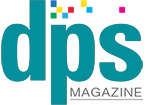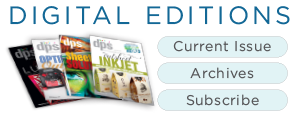
by Melissa Donovan
The publishing industry is constantly evolving. The written word is now consumed and presented in an abundance of forms—print, audio, video, and ebooks—it makes sense that the physical book is not required in as large a quantity as it once was.
Digital printing is perfectly designed to cater to this culture shift, whether it be limited runs of books—special collections and imprints, or smart publishers looking to effectively manage inventory. Book block digital printing is especially advantageous when web- or roll-fed presses are used, as higher speeds are typically achieved.
Trends That Support Digital
The publishing world and by extension book block printing is transitioning to shorter runs, so it is no surprise that digital is the technology of choice.
Trends in publishers’ production strategies support the prominence of digital print. “Printing closer to publication date—rather than the six months or more out—due to retailers’ changing order patterns is now common. Lower unit initial runs followed by more frequent and more tightly scheduled reprints regularly occur. Printing closer to warehousing and distribution facilities to mitigate supply chain disruption and reduce the carbon footprint of ‘book miles’ is not unheard of. Printing in market to avoid potential tariff-related delays at ports in the U.S. and to comply with European sustainability regulations like the European Deforestation Regulation are strategies employed by publishers,” outlines Ashley Gordon, publishing segment manager, HP PageWide Industrial.
The way books are introduced to the market also make digital printing and finishing attractive options. “This is driven by the strength of the physical bookstore as a discovery and sales channel and by social media platforms like TikTok’s BookTok and Instagram where influencers use the physical book in their video testimonials, like the ‘unboxing’ trend of posting the act of opening a new subscription shipment of several books,” explains Gordon.
These books are usually special collectors’ editions of previously published books or matching sets, and can include colorful edge printing with elaborate designs, custom end papers, or spot gloss and foil on the cover—all achieved with digital technologies, suggests Gordon.
“There’s a clear shift toward shorter runs, faster turnaround, and automated production—all driven by changes in how books are consumed, ordered, and distributed. Publishers are reevaluating their supply chains to avoid overstocking, reduce warehousing costs, and better meet unpredictable demand. That’s where digital excels,” explains Kent Wolford, marketing director North America, Xeikon.
Automation and sustainability are trends found in publishing. “Today’s book manufacturers need production lines that are not only flexible, but intelligent-automated systems that move from white paper roll to finished book block with minimal touch points. We also see growing demand for sustainable, waste-reducing processes, as well as tighter integration between digital presses and finishing equipment,” shares Wolford.
Customization is prevalent. Digital technologies support variable data printing. “Each book block can be tailored, whether it’s for personalized covers or unique content,” explains Michael Poulin, senior manager – inkjet press solutions, FUJIFILM North America Corporation.
“Automation, cost reduction, and speed to market are the keys to developing solutions to serve the current interests of book manufacturers. Overall production operations follow the industry objectives and look at every chance to become as efficient as possible while addressing labor and cost issues,” notes Stephen Sanker, national sales director, digital web, Koenig & Bauer US.
Growth Statistics
Digital printing’s use in publishing continues to grow in the U.S., expanding beyond more common segments like textbooks to niche books influenced by social media trends.
“Digital book printing experienced significant growth in recent years and is increasingly becoming popular due to publishers’ demands for shorter print runs and quick job turnarounds. This trend is expected to continue,” foresees Andrea Connor, WW solutions marketing manager, Kodak.
As a testament to the importance of digital print and the future of book manufacturing, Lisa Weese, director, product strategy and product planning; and Lucy Perez-Sierra, product strategy, Canon U.S.A., Inc., cite BR Printers’ recent book market analysis. “The volume of book pages printed digitally has surged in recent years. In 2022, approximately 326 billion book pages were printed, with the number of pages printed on digital inkjet presses increasing by 925 percent since 2014.”
Wolford admits that “while exact percentages vary by segment, it’s fair to say that double-digit market share for digital is now the norm, not the exception. In some niches, such as academic publishing, manuals, or self-publishing platforms, digital printing dominates. There is strong growth in digitally printed books with frequent updates like textbooks or guides, short shelf life—event-based or seasonal content, and unpredictable demand such as niche topics or long-tail titles.”
Books commonly produced digitally are short run and print on demand titles, self-published works, and books influenced by social media trends, list Weese and Perez-Sierra.
“Books with limited print runs or those produced as needed are ideal candidates for digital printing, reducing inventory costs and waste. Platforms like Amazon’s Kindle Direct Publishing empower authors to produce and distribute their books digitally, leading to a significant increase in self-published titles. Genres popularized through platforms like TikTok’s BookTok community often experience sudden spikes in demand, making digital printing a flexible solution to meet these fluctuations,” say Weese and Perez-Sierra.
The use of digital print in book publishing even five years ago is much different that today. “Once used almost exclusively for perfect-bound, mono paperbacks at the end of their life cycle via print on demand or for books with little sales demand produced only in short runs, digital production now applies from the first day of a book’s life cycle and all through its peak and slower sales periods as publishers look to mitigate supply chain risk, more economically manage inventory, and never miss a sale,” stresses Gordon.
What’s changed over the years is that digital is no longer only for prototypes or reprints. “It’s a strategic tool to control inventory, eliminate waste, and react faster to market needs,” says Wolford.
The quality-to-cost ratio has improved. “Over the past few years, what I think has changed is the quality and cost effectiveness of digital printing,” notes Poulin.
He says today’s digital presses deliver “incredible print quality that rivals offset while the cost per book allows for longer runs, so publishers are feeling more confident than ever about switching to digital, even for books where quality is critical.”
“Pressure is increasing in all areas of production, while acquisition/consolidation and ownership changes are driving a lot of these dynamics and forcing some of the issues to the surface. Digital printing plays a role in speed to market and addresses the labor challenges a lot of manufacturers face. Finding the right balance between the cost of production and turnaround times is becoming more essential,” adds Sanker.
Hybrid Printing
Instances of hybrid—digital and analog—printing in the publishing world continue to grow. Many vendors say that the combination of both technologies is actually preferred.
Due to market demand and the way consumers buy books, a hybrid model may make sense. “Combining conventional methods along with digital methods under one roof is a necessary strategy for most manufacturers. Minimum order quantities are diminishing and titles are increasing, thus, the ability to serve both ends of the spectrum hasbecome essential for the leaders of the industry,” states Sanker.
Many modern print providers integrate both legacy offset and digital presses to cater to more clients, from mass market paperbacks to short-run, self-published books, adds Poulin.
“Hybrid production scenarios are quite common, with the high-pagination book block—often just black text or black plus some spot color—being printed digitally, while the cover is printed in full color using traditional offset printing. However, digital printing is increasingly popular for printing book covers,” admits Connor.
Wolford believes a hybrid workflow is strategic. “Publishers may use offset for large first runs, then switch to digital for reprints, backlist titles, or niche markets. Others combine offset-printed covers with digitally printed interiors—or vice versa. Some print interiors digitally and outsource cover production separately.”
“This approach allows publishers and printers to combine the cost effectiveness of offset for large runs with the flexibility of digital for short runs, customization, and rapid turnaround,” share Weese and Perez-Sierra. While the initial larger runs might benefit from offset print technology, the reverse can also hold true, “where publishers will test the market with smaller print runs produced digitally and, if successful, will move to larger runs produced with offset,” they continue.
According to Gordon, “the objective is to create a balance between demand and supply, so the book is never out of stock but the inventory is as low as possible to reduce overhead and capital costs. A well-managed production and inventory strategy provides a competitive edge among publishers in a tight consumer market. Having a print vendor that offers a variety of digital solutions in addition to analog is key to achieving this balance.”
Roll-Fed Digital Printing
Beyond the base advantages of simply using digital print, continuous-feed digital printing in book block production offers added benefits.
“Book block production is web oriented and converting this form of paper stock is most efficient via web-based solutions and keeps the cost of material handling lower than sheeting prior to print production,” explains Sanker.
When compared to sheetfed digital presses, Connor points out that web-or continuous-fed digital presses offer “significantly higher printing speeds and faster production. Furthermore, a streamlined press operation means fewer operators when compared to sheetfed digital and offset presses, resulting in tangible labor savings and enhanced productivity. And compared to sheetfed book printing, printers like the Kodak PROSPER Presses score additional points in that they do not use paper sheets but rather more cost-effective roll paper.”
High-speed production and cost efficiency for medium- to small-volume print runs are positives for web-fed digital printing. Others “include on demand scalability, allowing books to be printed as needed without maintaining large inventories. Advantages extend to consistent and reproducible prints, ensuring a book printed today will look identical to one printed months later. Additionally, the process is easy to operate and does not require labor trained in offset printing,” share Weese and Perez-Sierra.
Automation, waste reduction, and sustainability are additional advantages. “Automation is ideal for inline book block production, reducing labor and handling. Waste reduction is achieved through precise pagination and versioning limit overprint. Efficient use of paper, energy, and toner makes for a sustainable print process,” explains Wolford.
Overall, the flexibility offered by digital print is one of the main benefits related to book block production. “In today’s market, where shorter runs, customization, and on demand printing are becoming the norm, digital roll-fed presses allow print providers to operate efficiently and adapt to variable demand. Digital makes it easier to print only what’s needed, when it’s needed, without the upfront costs of lengthy setups,” notes Poulin.
There are limitations to using roll-fed digital printing in book production.
For instance, it is not always economical for certain size runs. “Limitations include being less cost effective than offset printing for very large print runs, as well as being less economical than sheetfed inkjet for very small runs,” say Weese and Perez-Sierra.
Related to cost is the initial investment. As Wolford cautions, digital does “require careful return on investment planning and business case preparation.”
Substrate restrictions are also common, however Weese and Perez-Sierra admit these are gradually reducing as more papers are developed and qualified for inkjet use.
Digital Critical to Publishing
Today’s publishing model is supported by achievements in high-speed, continuous-feed inkjet technologies as short- to medium-runs are the norm.
Sep2025, DPS Magazine



